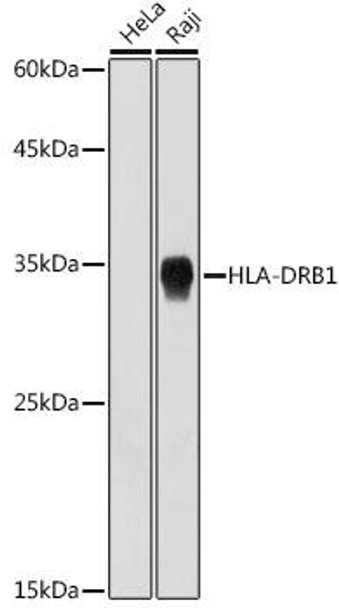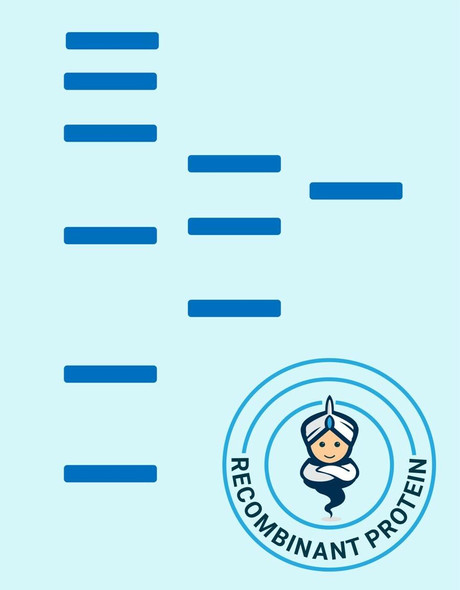Anti-HLA-DRB1 Antibody (CAB19835)
- SKU:
- CAB19835
- Product type:
- Antibody
- Antibody Type:
- Monoclonal Antibody
- Reactivity:
- Human
- Host Species:
- Rabbit
- Isotype:
- IgG
- Synonyms:
- DRB1
- HLA-DR1B
- HLA-DRB
- SS1
Frequently bought together:
Description
| Product Name: | HLA-DRB1 Rabbit mAb |
| Product Code: | CAB19835 |
| Size: | 20uL, 50uL, 100uL |
| Synonyms: | DRB1, HLA-DR1B, HLA-DRB, SS1 |
| Applications: | WB, IHC |
| Reactivity: | Human |
| Host Species: | Rabbit |
| Immunogen: | A synthesized peptide derived from human HLA-DRB1 |
| Applications: | WB, IHC |
| Recommended Dilutions: | WB 1:500 - 1:2000 IHC 1:50 - 1:200 |
| Reactivity: | Human |
| Positive Samples: | HeLa, Raji |
| Immunogen: | A synthesized peptide derived from human HLA-DRB1 |
| Purification Method: | Affinity purification |
| Storage: | Store at -20°C. Avoid freeze / thaw cycles. Buffer: PBS with 0.02% sodium azide, 0.05% BSA, 50% glycerol, pH7.3. |
| Isotype: | IgG |
| Sequence: | Email for sequence |
| Gene ID: | 3123 |
| Uniprot: | P01911 |
| Calculated MW: | 29kDa |
| Observed MW: | 33KDa |
| UniProt Protein Function: | HLA-DRB1 iso2: Binds peptides derived from antigens that access the endocytic route of antigen presenting cells (APC) and presents them on the cell surface for recognition by the CD4 T-cells. The peptide binding cleft accommodates peptides of 10-30 residues. The peptides presented by MHC class II molecules are generated mostly by degradation of proteins that access the endocytic route; where they are processed by lysosomal proteases and other hydrolases. Exogenous antigens that have been endocytosed by the APC are thus readily available for presentation via MHC II molecules; and for this reason this antigen presentation pathway is usually referred to as exogenous. As membrane proteins on their way to degradation in lysosomes as part of their normal turn-over are also contained in the endosomal/lysosomal compartments; exogenous antigens must compete with those derived from endogenous components. Autophagy is also a source of endogenous peptides; autophagosomes constitutively fuse with MHC class II loading compartments. In addition to APCs; other cells of the gastrointestinal tract; such as epithelial cells; express MHC class II molecules and CD74 and act as APCs; which is an unusual trait of the GI tract. To produce a MHC class II molecule that presents an antigen; three MHC class II molecules (heterodimers of an alpha and a beta chain) associate with a CD74 trimer in the ER to form a heterononamer. Soon after the entry of this complex into the endosomal/lysosomal system where antigen processing occurs; CD74 undergoes a sequential degradation by various proteases; including CTSS and CTSL; leaving a small fragment termed CLIP (class-II-associated invariant chain peptide). The removal of CLIP is facilitated by HLA-DM via direct binding to the alpha-beta-CLIP complex so that CLIP is released. HLA-DM stabilizes MHC class II molecules until primary high affinity antigenic peptides are bound. The MHC II molecule bound to a peptide is then transported to the cell membrane surface. In B-cells; the interaction between HLA-DM and MHC class II molecules is regulated by HLA-DO. Primary dendritic cells (DCs) also to express HLA-DO. Lysosomal miroenvironment has been implicated in the regulation of antigen loading into MHC II molecules; increased acidification produces increased proteolysis and efficient peptide loading. Genetic variation in HLA-DRB1 is a cause of susceptibility to sarcoidosis type 1 (SS1). Sarcoidosis is an idiopathic, systemic, inflammatory disease characterized by the formation of immune granulomas in involved organs. Granulomas predominantly invade the lungs and the lymphatic system, but also skin, liver, spleen, eyes and other organs may be involved. Belongs to the MHC class II family. |
| UniProt Protein Details: | Protein type:Membrane protein, integral Chromosomal Location of Human Ortholog: 6p21.3 Cellular Component: cell surface; Golgi membrane; late endosome membrane; lysosomal membrane; membrane; MHC class II protein complex; plasma membrane; trans-Golgi network membrane Molecular Function:peptide antigen binding Biological Process: antigen processing and presentation of exogenous peptide antigen via MHC class II; polysaccharide assembly with MHC class II protein complex; T cell costimulation; T cell receptor signaling pathway |
| NCBI Summary: | HLA-DRB1 belongs to the HLA class II beta chain paralogs. The class II molecule is a heterodimer consisting of an alpha (DRA) and a beta chain (DRB), both anchored in the membrane. It plays a central role in the immune system by presenting peptides derived from extracellular proteins. Class II molecules are expressed in antigen presenting cells (APC: B lymphocytes, dendritic cells, macrophages). The beta chain is approximately 26-28 kDa. It is encoded by 6 exons. Exon one encodes the leader peptide; exons 2 and 3 encode the two extracellular domains; exon 4 encodes the transmembrane domain; and exon 5 encodes the cytoplasmic tail. Within the DR molecule the beta chain contains all the polymorphisms specifying the peptide binding specificities. Hundreds of DRB1 alleles have been described and typing for these polymorphisms is routinely done for bone marrow and kidney transplantation. DRB1 is expressed at a level five times higher than its paralogs DRB3, DRB4 and DRB5. DRB1 is present in all individuals. Allelic variants of DRB1 are linked with either none or one of the genes DRB3, DRB4 and DRB5. There are 4 related pseudogenes: DRB2, DRB6, DRB7, DRB8 and DRB9. [provided by RefSeq, Jul 2008] |
| UniProt Code: | P01911 |
| NCBI GenInfo Identifier: | 166214928 |
| NCBI Gene ID: | 3123 |
| NCBI Accession: | P01911.2 |
| UniProt Secondary Accession: | P01911,Q29790, Q29975, Q30142, Q30166, Q32MY7, Q56FN9 Q5Y7B0, Q5Y7B9, |
| UniProt Related Accession: | P20039,Q5Y7A7,Q95IE3,Q9GIY3,Q29974,P01912,Q30134,P04229,P01911,Q30167 |
| Molecular Weight: | 29,966 Da |
| NCBI Full Name: | HLA class II histocompatibility antigen, DRB1-15 beta chain |
| NCBI Synonym Full Names: | major histocompatibility complex, class II, DR beta 1 |
| NCBI Official Symbol: | HLA-DRB1 |
| NCBI Official Synonym Symbols: | SS1; DRB1; DRw10; HLA-DRB; HLA-DR1B |
| NCBI Protein Information: | major histocompatibility complex, class II, DR beta 1 |
| UniProt Protein Name: | HLA class II histocompatibility antigen, DRB1-15 beta chain |
| UniProt Synonym Protein Names: | DW2.2/DR2.2; MHC class II antigen DRB1*15 |
| Protein Family: | HLA class II histocompatibility antigen |
| UniProt Gene Name: | HLA-DRB1 |
| UniProt Entry Name: | 2B1F_HUMAN |










